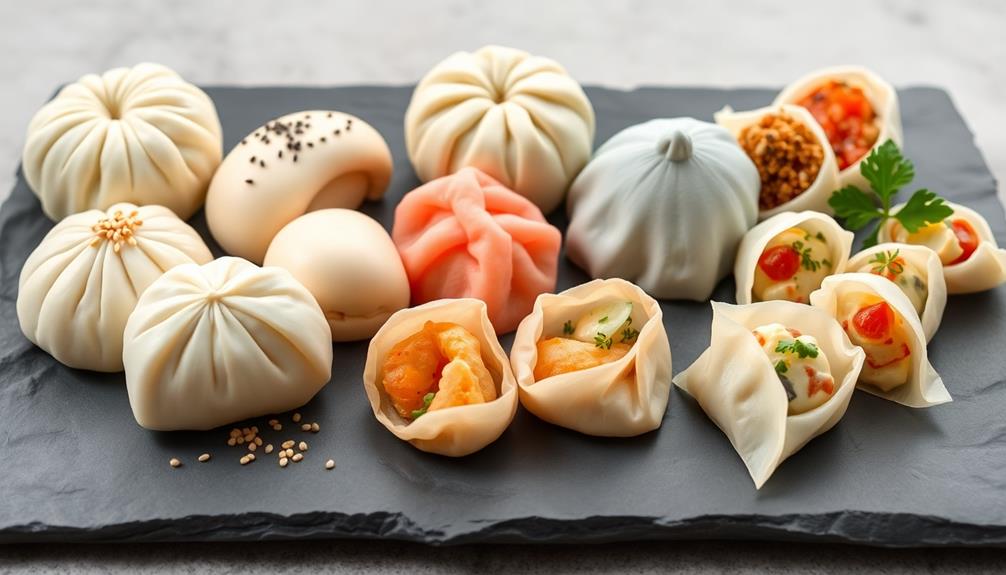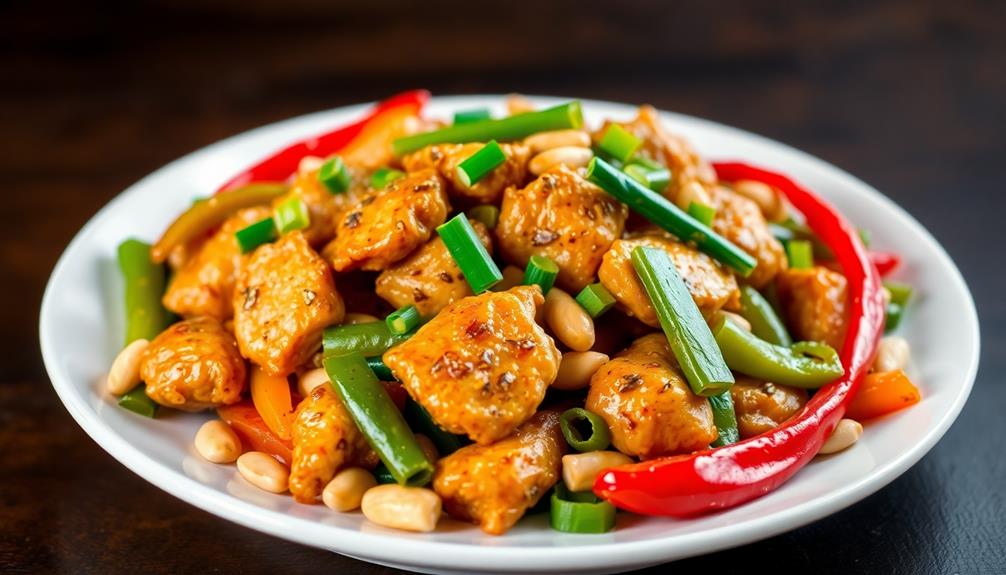Dim sum is a scrumptious Cantonese tradition where you can savor a delightful array of small plates and sip fragrant tea. It originated in Guangdong province, China and has become a cherished part of the culture. You'll find bite-sized dishes like pork dumplings, buns, and pastries that you can share with family and friends, encouraging lively conversation and a sense of community. The diverse flavors and textures will tantalize your taste buds, and you can even customize your experience by trying new and exotic dishes. If you're curious to learn more about the fascinating history and traditions of dim sum, keep reading!
Key Takeaways
- Dim Sum is a traditional Cantonese culinary experience featuring small plates of savory and sweet delicacies served alongside tea.
- Dim Sum represents a cherished part of Cantonese culture, with a social dining experience that encourages lively conversations and community.
- The Dim Sum menu offers a wide range of dishes, including dumplings, buns, and pastries, showcasing unique flavors and a diverse culinary heritage.
- Serving Dim Sum items in steamer baskets and accompanying them with dipping sauces are essential aspects of the traditional preparation and dining experience.
- Dim Sum is often enjoyed during brunch or lunch hours, reflecting the communal approach to dining and the preservation of traditional cooking methods and recipes.
History
Originating in the Guangdong province of China, dim sum evolved from the Cantonese tradition of yum cha, or "drinking tea."
As the custom spread, small plates of savory and sweet delicacies were served alongside the tea, creating a unique dining experience. You might've sampled some of these tasty treats, like fluffy steamed buns filled with barbecued pork or delicate dumplings bursting with savory fillings.
These bite-sized dishes were designed to be shared, encouraging lively conversation and social interaction over a cup of fragrant tea.
Over time, the practice of enjoying dim sum grew in popularity, becoming a cherished part of Cantonese culture.
Today, you can find dim sum restaurants all over the world, where the classic flavors and traditions are still celebrated, inviting you to savor the rich history and flavors of this beloved culinary experience.
Recipe
Dim Sum is a Cantonese cuisine where a variety of small dishes and appetizers are served in steamer baskets or on small plates.
It's traditionally enjoyed during the morning or early afternoon hours as a social dining experience.
To recreate this authentic Dim Sum experience at home, follow this recipe. The key is to have all the ingredients prepared and ready to go before you start cooking, as Dim Sum is all about the quick assembly and serving of multiple dishes.
- Pork Shumai (Pork Dumplings)
- Shrimp Dumplings
- Char Siu Bao (Barbecue Pork Buns)
- Chive Dumplings
- Egg Tarts
In a large steamer, arrange the Dim Sum items in the steamer baskets, being careful not to overcrowd.
Steam each item for 8-10 minutes until cooked through. Serve the Dim Sum items immediately, arranging them on a large platter.
Provide dipping sauces such as soy sauce, chili oil, and black vinegar on the side.
When cooking Dim Sum at home, remember to work quickly, as the dishes are meant to be fresh and served hot.
Enlist help from family or friends to make the preparation and serving process smoother.
Enjoy this interactive dining experience with your loved ones.
Cooking Steps
First, you'll need to prepare your steamer basket by lining it with a thin cloth or parchment paper.
Next, gather all the tasty filling ingredients like minced pork, shrimp, mushrooms, and veggies.
Then, it's time to wrap up those delectable dim sum parcels! Carefully place the fillings into the dough wrappers and seal them up.
Step 1. Prepare the Steamer Basket
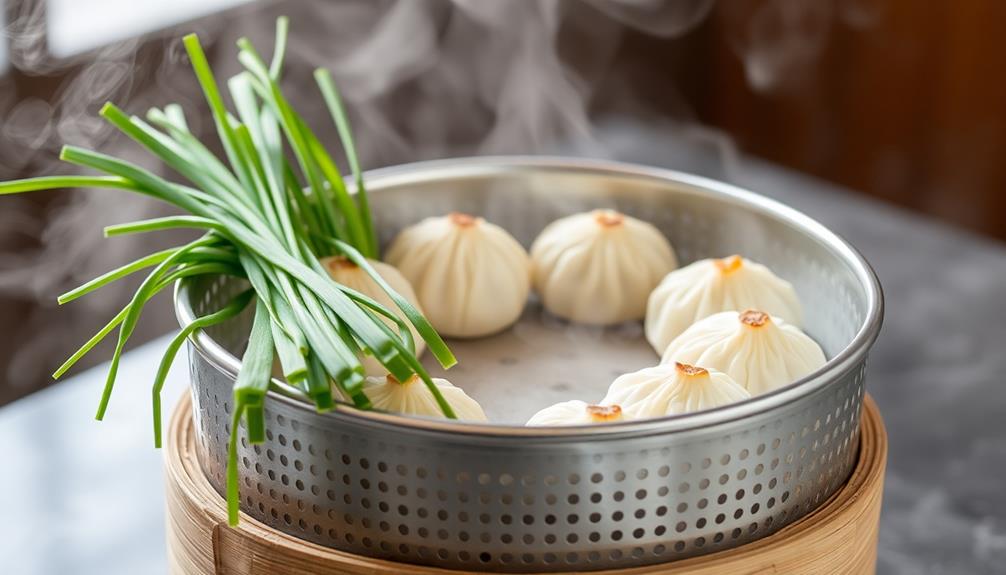
Preparing the steamer basket is an essential step in crafting delectable dim sum. First, select a sturdy bamboo steamer that fits snugly inside your pot or wok. Line the bottom with parchment paper or cabbage leaves to prevent sticking.
Arrange the dim sum items carefully, leaving enough space between them for even cooking. Be sure not to overcrowd the basket, as this can cause the food to steam unevenly.
Now, bring water to a gentle simmer in the pot or wok. Gently place the steamer basket inside, making sure the water doesn't touch the bottom. Cover the basket with a lid, and let the dim sum steam for the recommended time, usually 10-15 minutes.
Keep an eye on the water level, adding more as needed to maintain a steady stream of steam.
When the timer goes off, use tongs to carefully remove the hot steamer basket. Serve the freshly steamed dim sum immediately for maximum enjoyment and flavor.
With a perfectly prepared steamer basket, you're well on your way to an authentic dim sum experience!
Step 2. Prepare the Filling Ingredients
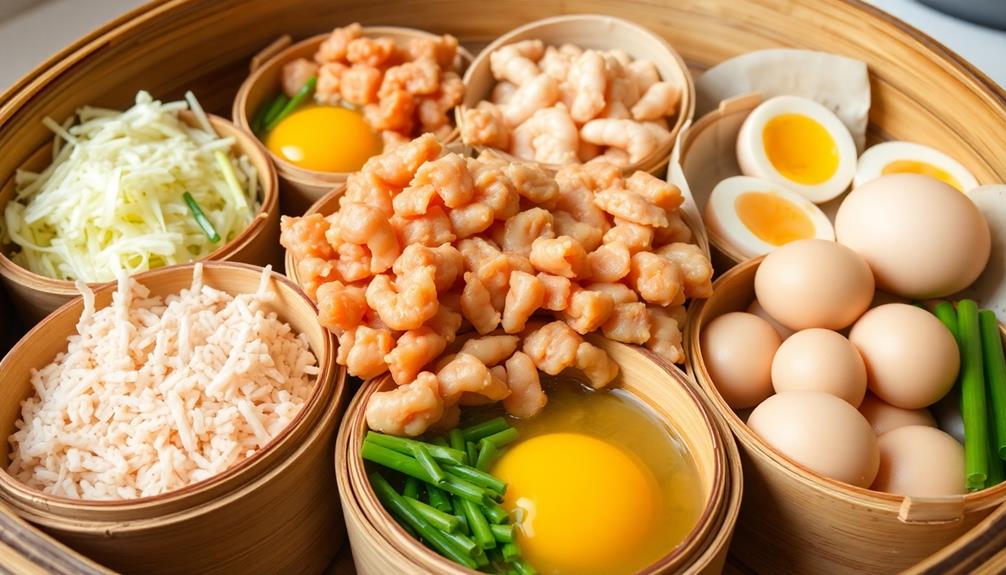
The preparation of the filling ingredients is a crucial step in crafting exquisite dim sum. First, you'll need to gather your favorite fillings, like minced pork, shrimp, mushrooms, or vermicelli noodles.
Finely chop or mince the ingredients so they'll fit nicely inside the delicate dumplings. Don't forget to season the fillings with a pinch of salt, white pepper, and a splash of soy sauce – this will make the flavors really pop!
Next, you'll want to sauté the filling ingredients in a hot pan with a bit of oil. This helps to blend the flavors and gives the filling a wonderful texture.
Be sure to stir frequently so nothing sticks or burns. Once the filling is cooked through, let it cool slightly before assembling your dim sum.
With your flavorful fillings ready to go, you're one step closer to creating mouthwatering dim sum masterpieces! Just wait until you see the delight on your family's faces when they take their first bite.
Step 3. Assemble the Dim Sum Parcels
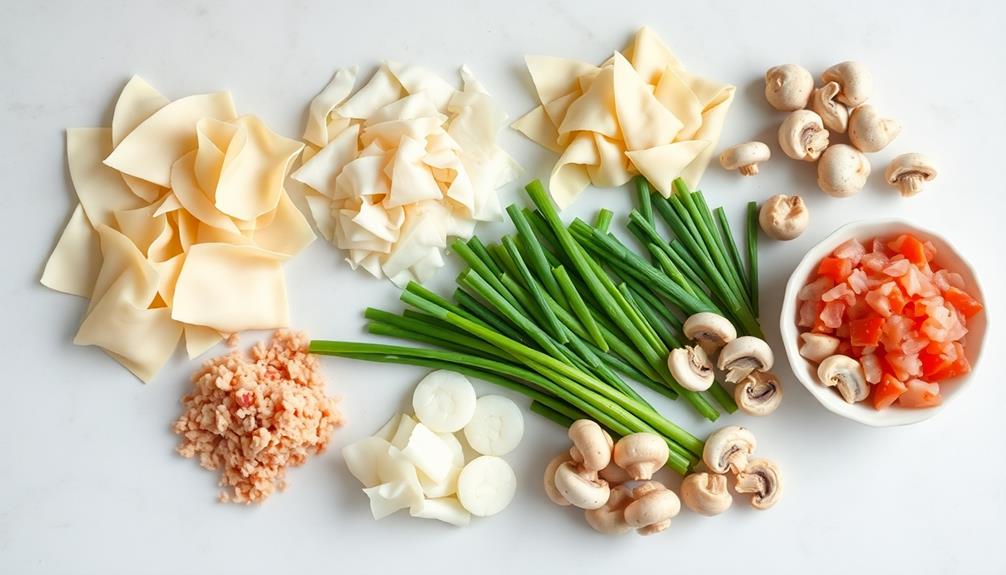
With your flavorful fillings ready, the next step is to assemble the dim sum parcels.
Grab a clean, lightly floured surface and place a single wonton or dumpling wrapper in front of you. Using a spoon, place a small amount of your delicious filling into the center of the wrapper. Be careful not to overstuff, as you'll need room to seal the parcel.
Gently fold the wrapper in half, creating a semi-circle shape. Press the edges firmly to seal, making sure there are no gaps or holes. If the wrapper isn't sticking, you can use a bit of water to help it adhere.
Next, crimp and pleat the sealed edge to create that classic dim sum look. Repeat this process until you've used up all your filling.
Now your parcels are ready to be steamed or fried to golden perfection! Get ready to enjoy the wonderful flavors you've created.
Step 4. Steam the Dim Sum Parcels
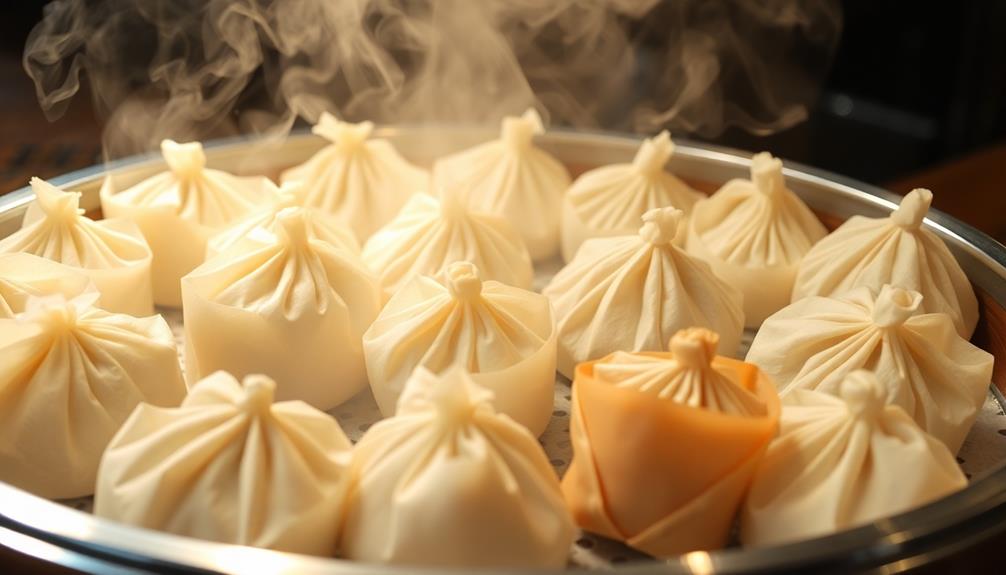
Now that your dim sum parcels are assembled, it's time to steam them to perfection. You'll need to grab a large pot with a tight-fitting lid, as well as a steamer insert or bamboo steamer basket. Fill the pot with about 2 inches of water, being careful not to let the water touch the bottom of the steamer. Bring the water to a boil over high heat.
Once the water is bubbling, carefully place the dim sum parcels in the steamer, making sure they're not touching each other. This will ensure even cooking.
Cover the pot with the lid and steam the parcels for about 10 to 15 minutes, depending on their size. You'll know they're done when they're hot throughout and the dough is tender and fluffy.
Remove the lid with caution, as the steam will be very hot. Serve the steamed dim sum immediately, while they're piping hot and fresh. Don't forget the dipping sauces! Enjoy your delicious homemade dim sum.
Step 5. Serve Warm With Dipping Sauces
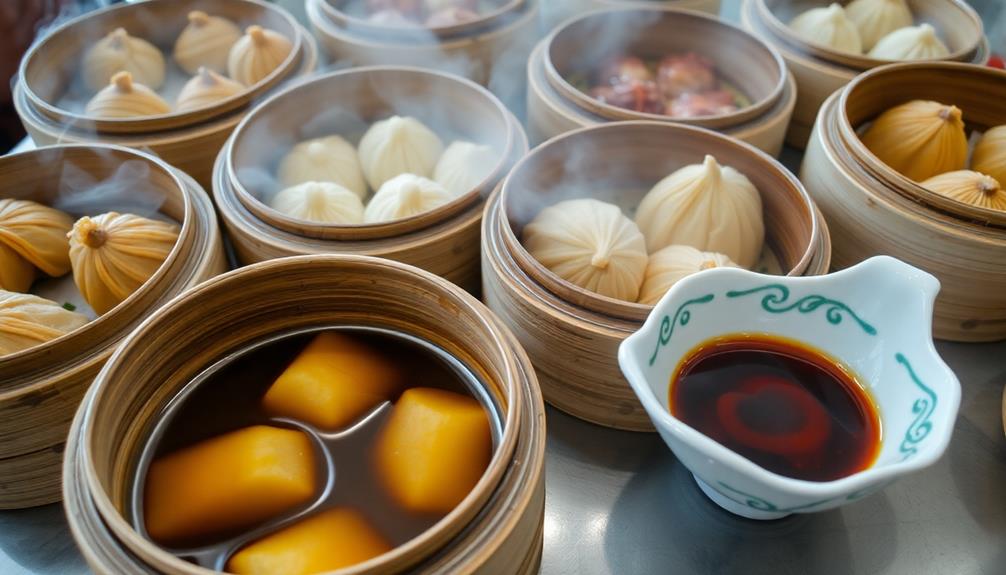
Piping hot and fresh, serve the steamed dim sum immediately. Don't let those delectable dumplings cool off – they're best enjoyed straight from the steamer!
Arrange the parcels attractively on a serving platter, placing them close together so your guests can easily pick and choose.
Now, it's time for the fun part – the dipping sauces! Offer a variety of tasty condiments like soy sauce, chili oil, and sweet chili sauce. Encourage your diners to get creative and experiment with different flavor combinations. The salty, sweet, and spicy notes will perfectly complement the savory fillings.
Don't be afraid to get hands-on! Dim sum is all about the interactive experience. Dip, dunk, and savor each delightful bite, exploring the vibrant textures and aromas. Whether you’re using chopsticks or just your fingers, the joy comes from engaging with the food. Don’t miss out on trying the infamous dim sum style chicken feet – a tender, flavorful bite that’s a favorite among dim sum lovers. It’s a dish that perfectly embodies the adventurous spirit of this beloved culinary tradition.
With every delectable morsel, you'll be whisked away to the bustling streets of Hong Kong. So, gather your loved ones, dive in, and enjoy this authentic taste of Chinese culinary delight!
Final Thoughts
Ultimately, your journey through the flavors and traditions of dim sum has likely left you with a newfound appreciation for this delightful culinary experience.
You've discovered the joys of steaming hot buns, delicate dumplings, and mouthwatering sweets. From the bustling atmosphere of a dim sum restaurant to the intricate preparation techniques, you've gained a deeper understanding of this cherished Cantonese tradition.
As you reflect on your dim sum adventure, remember that it's not just about the food – it's about the shared moments, the lively conversations, and the sense of community that surrounds this social dining experience.
Whether you're exploring a new dim sum spot or revisiting a favorite, approach each meal with an open mind and a willingness to try new things. The beauty of dim sum lies in its diversity, so don't be afraid to step out of your comfort zone and savor the unexpected flavors that await.
Frequently Asked Questions
What Are the Typical Serving Sizes for Dim Sum Dishes?
The typical serving size for dim sum dishes can vary, but you can generally expect smaller portions, often designed for sampling and sharing. The dishes are meant to be shared and enjoyed in a communal setting.
Is Dim Sum Only Served During Certain Times of the Day?
You may only be able to order dim sum during certain hours of the day. Many restaurants offer it during the morning and early afternoon, as it's traditionally a brunch-style meal.
Can I Order Dim Sum for Takeout or Delivery?
Yes, you can typically order dim sum for takeout or delivery. Many restaurants offer these options, allowing you to enjoy the dishes at home or on the go.
Are There Any Vegetarian or Gluten-Free Dim Sum Options Available?
Yes, many dim sum restaurants offer vegetarian and gluten-free options for takeout or delivery. You'll find steamed buns, dumplings, and other dishes that cater to dietary restrictions. Just be sure to ask about the available selections.
How Long Do Dim Sum Dishes Typically Take to Prepare?
Typically, dim sum dishes don't take long to prepare, usually around 15-30 minutes. The speed is due to the small portion sizes and specialized cooking techniques used in these bite-sized delights. You can expect your dim sum favorites to come out promptly.
